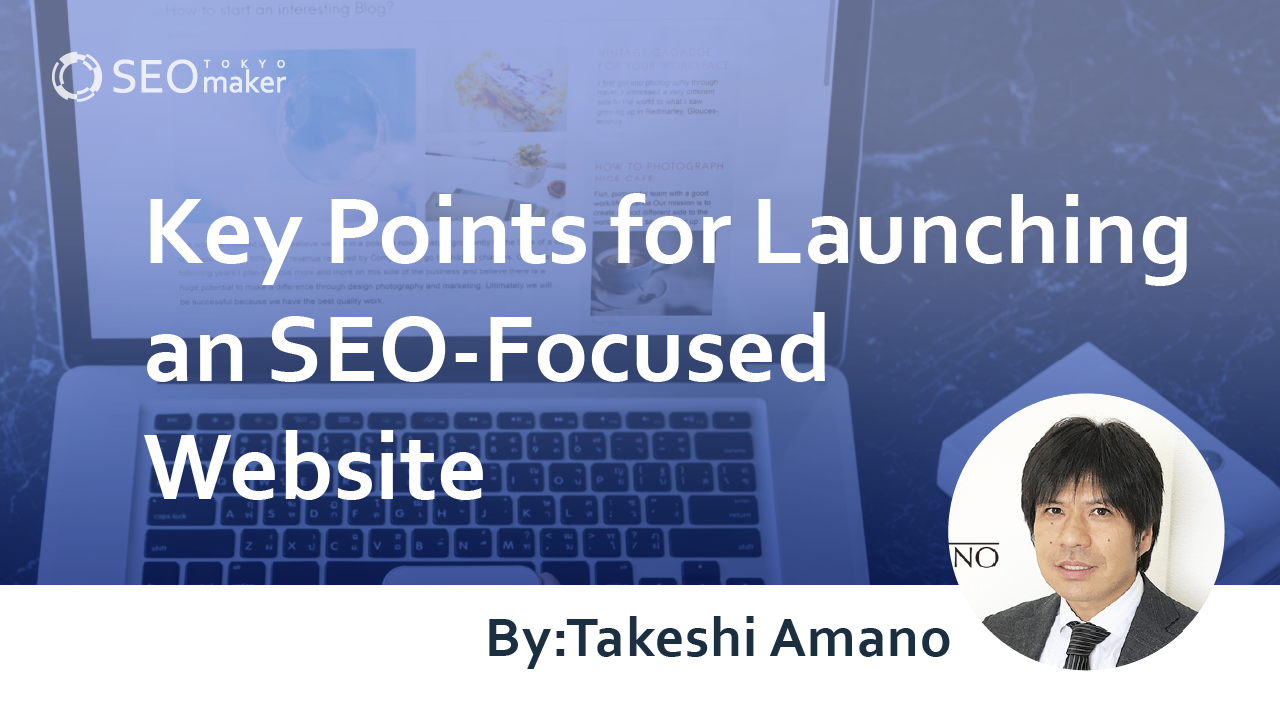Key Points for Launching an SEO-Focused Website :Beginner to Intermediate
contents
- 1 What Does It Mean to Build an SEO-Focused Website?
- 2 Optimal Timing for SEO
- 2.1 The Essence of SEO: Keywords
- 2.2 Choosing Keywords with User Search Intent in Mind
- 2.3 Recognize That Some SEO Tactics Can Backfire Today
- 2.4 What Should Current SEO Strategies Focus On?
- 2.5 Adding Content Easily with a Blog on Your Site
- 2.6 Learning Web Writing If you plan to write the content yourself, I recommend learning about web writing.
- 2.7 Quality and Credibility in Content
- 3 Summary

Today, we’ll explore the essentials of launching a website with SEO (Search Engine Optimization) in mind.
What Does It Mean to Build an SEO-Focused Website?
Even in the era dominated by social media, it’s almost expected for businesses and shops to have their own websites.
Setting up a personal website is not a high hurdle either.
There are services that allow you to create your own website for free, including registration and maintenance.
Currently, the internet is flooded with countless websites.
In such a scenario, the technique to make your website stand out and attract users is what SEO is all about.
Consultation Request
How can I focus on SEO from the time of website launch?
I work as an illustrator. Until now, I’ve used social media as my platform, but I plan to launch a website soon. I’ve been researching and understand that I should implement SEO, but I’m not quite sure what exactly to do. The more I research, the more confused I get, as it seems like some sources suggest doing the opposite.
What exactly should I do for SEO? I would like to start off with a website optimized for SEO from the beginning.
Optimal Timing for SEO
The best time to perform SEO is during a website’s launch or renewal.
Structural changes, like URL and menu configurations, are cumbersome to modify later. Therefore, it’s better to design your site with SEO in mind from the start.
Of course, it’s possible to implement SEO on an existing site, but altering the structure of a long-operating site with numerous pages can be complex. In such cases, a renewal presents an ideal opportunity for SEO. Sometimes, replacing an old system with a new one, despite various limitations and technical issues, might be advisable.
The Essence of SEO: Keywords
The first step in SEO is deciding on your target keywords.
With the vast array of words available, it’s impossible to optimize for every search term.
Before taking specific actions, you must narrow down which keywords you will focus on.
If you can accurately decide on your keywords, it’s easier to gauge the effectiveness of your SEO efforts.
♦Example on How to Choose Keywords:
For instance, for a café near Shinjuku Station in Tokyo, the first keywords that might come to mind are “Shinjuku café” or “Tokyo café.”
If your business is a brick-and-mortar that relies on physical customer visits, it’s typical to use “(location) + (business type)” as keywords.
However, in a major metropolitan area, this alone may not be enough due to high competition. In such cases, consider narrowing down further by thinking about what makes your store unique.
Example: If affordability is your selling point, “cheap café near Shinjuku” might be your keyword.
You may need to consider other factors, such as proximity to the nearest station if your store is within walking distance, or accessibility from major roads if your business relies on car traffic.
However, this shift in conditions would be different if you have a unique selling point that attracts customers from far away.
For the consulting illustrator, focusing on location might not be necessary since many illustrator transactions from commission to delivery are completed entirely online.
However, targeting broad terms like “illustration” may be too competitive for top rankings. It’s advisable to start by picking words that highlight your strengths and the unique aspects of your illustrations.
And in choosing your keywords, it’s crucial to think about the users you want visiting your site. Reevaluate who you want to attract to your website.
Choosing Keywords with User Search Intent in Mind
A fundamental aspect of creating content for websites is selecting keywords while always considering the potential users. This should lead to web pages that match as many searches as possible.
When deciding on themes or titles, think about the user’s search intent and deliver content that is useful to them. This approach helps your content to be valued by search engines and improves its ranking.
Here, I’d like to introduce some handy tools and how to use them for keyword selection.
Keyword Planner
A great free tool is Google Ads’ (formerly Google AdWords) “Keyword Planner.”
Main functions of Keyword Planner:
- Search for new keywords
- Get forecasts and historical metrics
- Download the results
♦Example of using Keyword Planner
Example: Italian Restaurant
Searching for this term might show related keywords like “(Location) Italian.” Explore these related terms to narrow down your keyword choices.
When creating individual pages on your site, set specific keywords for each and develop content that aligns with them.
While it is possible to set different keywords for each page, it is recommended to set ‘slightly different keywords related to the main keyword‘ for each page. By structuring pages around related keywords, your site will have a higher chance of appearing in search results not only for the main keyword but also for related keywords.
Once a user visits your site, they will find that the site is comprehensive and covers all the information they need, making them more likely to stay longer and return in the future. This could eventually lead to orders and sales.
By creating pages that address both the main theme keywords and related keywords, you will build content that aligns with users’ search intentions.
Once the keywords for each page are decided, you can begin implementing specific SEO measures.
Recognize That Some SEO Tactics Can Backfire Today
When researching website creation, you will come across various pieces of information. Among them, you might find quite a bit about ‘SEO‘ aimed at improving the search ranking of your website.
However, effective SEO strategies change over time. Some strategies that were highly effective a few years ago can now be counterproductive and lower your ranking.
This is because search engine algorithms evolve at a rapid pace.
SEO refers to the general measures aimed at adjusting your site structure to be highly rated by search engines, thereby improving your search ranking.
The SEO strategies that were effective a few years ago were tailored to ‘the search engine algorithms of that time.’ Since then, these algorithms have continued to evolve and will likely continue to do so in the future.
SEO strategies naturally change along with the evolution of search engines. It is essential to recognize that old techniques no longer work.
Examples of outdated SEO strategies that are now ineffective
- Stuffing your website with keywords that might be used in search queries.
- Adding a large number of backlinks.
- Increasing ‘reciprocal links’ between websites.
- Ensuring many pages on your site are indexed.
- Filling your site with a large amount of text.
- Including any keywords you can think of in meta tags.
In the past, having many links or a high word count was considered beneficial content and tended to rank higher in search results.
However, blindly increasing word count or backlinks without providing substantial content does not benefit users who find your page through a search.
To address this, search engines like Google have been continuously improving their algorithms to ‘evaluate higher quality content.‘ This evolution has likely enhanced the usefulness of searches for users.
What Should Current SEO Strategies Focus On?
So how can you improve your search ranking?
It’s simple. Focus on improving the ‘quality of your content’ so that users find it valuable. To continue being highly ranked by evolving search engines, you must enhance the quality of your content and maintain a site that is beneficial to users, rather than relying on quick fixes.
Ideally, regularly review the content of your main pages, like the homepage, from the perspective of site visitors. Update the information to ensure it is current and in a format that is likely to be favorably evaluated by Google at that time. Simultaneously, continuously add high-quality content.
While this may sound easy, implementing it is not straightforward.
However, you can’t start if you’re hesitant from the beginning. SEO takes time to show results and generally tends to be a long-term effort.
Start steadily from what you can do.
Special caution is needed when performing SEO for websites such as the following.
- Websites with Specialized Themes or High Competition
For these, it’s crucial to focus more on niche themes and enhance the quality of the content. This makes content creation more challenging due to the higher level of specialization required.
- Websites That Have Been Inactive
If a site has been neglected, search engines might have marked it as ‘no need to revisit,’ which means special strategies may be necessary to regain their attention.
- Websites Previously Penalized for Spam
If a site is still flagged for spam, manual actions may be required to remove these penalties. It’s also essential to review and comply with guidelines to ensure all past spam actions are corrected.
Adding Content Easily with a Blog on Your Site
One easy way to add content is by setting up a blog page on your site.
In terms of SEO, this not only involves structural adjustments to the website but also operational strategies like creating useful blog posts for users.
For smaller websites, competing structurally with larger sites might not be feasible, so using a blog for SEO might be more effective.
Learning Web Writing If you plan to write the content yourself, I recommend learning about web writing.
What is Web Writing?
It’s a technique for crafting content specifically for web publication, including SEO-friendly composition and appropriate language use.
Web writing considers not just readability for human visitors but also how easily search engine crawlers can recognize and index the content.
Employing these techniques directly contributes to more effective SEO.
Quality and Credibility in Content
Originality is crucial for the content you implement on your site. However, originality alone doesn’t guarantee high rankings; in some cases, it could even lead to a lower ranking.
Let’s reconsider what originality means and what kind of content tends to improve search rankings.
What Does Originality Mean in Site Content?
Generally, it means including unique elements that differentiate your content from others on the web.
However, if these unique aspects contain issues that could question their credibility, it might negatively impact their rating. This is because Google values content that is both credible and of high quality.
So, what is credibility?
Ultimately, whether to trust the content is up to the users of the search engine, but from the search engine’s perspective, delivering highly credible information is preferable as it’s more likely to be beneficial for the users.
But should content, no matter how original, be placed in highly visible ranks without verifying its credibility, especially if it deviates significantly from established facts or information?
Ideally, only “accurate” information should be published, but determining accuracy requires extensive resources and can be extremely difficult depending on the content.
This area is likely to see further evolution in search engine algorithms in the future.
What Makes a Website Easy to Rank?
From this perspective, analyzing the top-ranked websites reveals a trend: these sites often have a broad yet deep scope of information, and they typically contain minimal unnecessary details.
If we consider this from the perspective of search users, it implies that websites that quickly answer queries, clarify related issues, and provide extensive, in-depth information tend to rank higher.
However, it’s not necessarily true that websites with excessive information always rank lower. There are many algorithms involved in determining search rankings, so it’s hard to generalize.
Summary
Combining the above insights, we can say that while original content is important, what’s even more critical and likely to be highly rated is [content that contains quality information useful to users]. Simply copying existing information is out of the question, but if you can intelligently combine existing information in a way that aligns with user intent, offering both quality and quantity, you might well find your content ranking high in search results. Furthermore, if you’re looking for specific advice on what content is likely to be highly valued or tips on how to implement it, our team is here to consult.










![What is a Description? Explaining the Meaning, Writing Style, and Changing Word Count – [2023 Edition]](https://www.switchitmaker2.com/en/wp-content/uploads/2024/09/what-is-description.webp)










